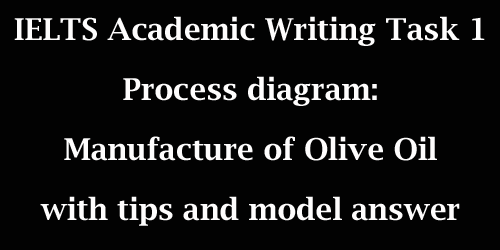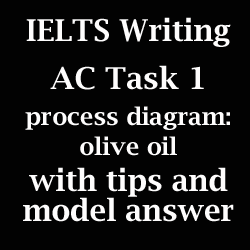IELTS Academic Writing Task 1: Process diagram; olive oil production; with tips and model answer
This IELTS Academic Writing Task 1 post is a presentation of writing a process diagram. A process diagram shows how a product is manufactured, recycled, or reused. In this post, I’ve selected the production or manufacture of olive oil. Hopefully, this post can work as a guide for answering any process diagram easily.

Let’s have a look at the title of this Task 1 and the picture.
The diagram shows the manufacturing process of olive oil of different grades.

When you are to answer a process diagram, think about the following points/ tips:
- A process has some stages that are orderly placed. So, your answer has to be started at the beginning, and you should explain each stage all the way through to the last one.
- The diagram will show you that there is a beginning point and an ending point.
- In a process diagram, you may need to look at the picture carefully as some stages might not be clearly explained and you need to find out the correct words or language for them.
- You must practice at least 5-10 different types of process diagrams to become skilled in writing the answer.
- Passive voice is often used in the description of the picture as the subject (the action performer) is not present in most cases. So, you should have a good idea about the passive voice.
- Your answer must contain linkers/discourse markers as this is a process. Here are some examples:
In the first stage, subsequently, then, next, after that, in the following step, finally, ultimately, etc.
Model answer:
The diagram illustrates the way in which olive oil of different grades is manufactured. Overall, harvested olives pass through nine to eleven stages before being bottled.
In the first stage of producing olive oil, selected olives are harvested by workers from the olive garden. The olives are then channeled to the collection vat which sends them to the washer tank. Here, the mechanical system completes the de-leafing and washing of the olives. Subsequently, they traverse the olive mill where the olives are crushed, and from there they are sent to the malaxer. In this stage, the olive paste is heated under 27⁰C and the paste is supplied to the centrifugal press which extracts pomace i.e. pulp residue and delivers the pulp to another mill where olive pomace oil is prepared.
The following stages are decanting and separating where fresh liquid oil is separated from solids and wastewater. Next, fresh and clean oil is stored in a large oil tanker. Ultimately, Extra Virgin Olive Oil and Virgin Olive Oil are produced by filtration and Refined Olive Oil is made by refining. In this way, the complex mechanical process churns out olive oil of different qualities.
(189 words)
Examiner’s review:
This diagram presents a terse or brief introduction. The overall comment contains key features of the picture while the body paragraph contains good organization and uses a number of linking devices flexibly yet in a controlled way. There is also a great use of passive voice as the subject is not present. The use of capitalization and spelling is correct. The writer has also used collocations or word associations accurately and the answer looks lucid and striking.
N.B: Please have a close look at the bold words. They make this writing stand out from others.
Here are some other diagrams that you can practice:
Flow-chart on sweater manufacturing
Process diagram on olive oil production
Two maps showing changes in an industrial village
Two maps showing changes in a town
Life cycle diagram on tuna fish
Life cycle diagram on silkworm moth
Cycle diagram on water movement
Diagram on water contamination
If you like this post, please make comments below. You can also provide your opinions or ask relevant questions on Writing Task 1.




Excuse me sir
I don’t understand why [olive paste is heated over 27⁰C]?
The diagram shows mixing <27⁰C means is that [olive paste is heated under 27⁰C] is right. Don’t you think so? It is because extra virgin and virgin oil is made Cool temperature pressing oil, I know that.
Dear Dave, thanks a lot for the suggestion. Yes, you are right and I corrected it just now.